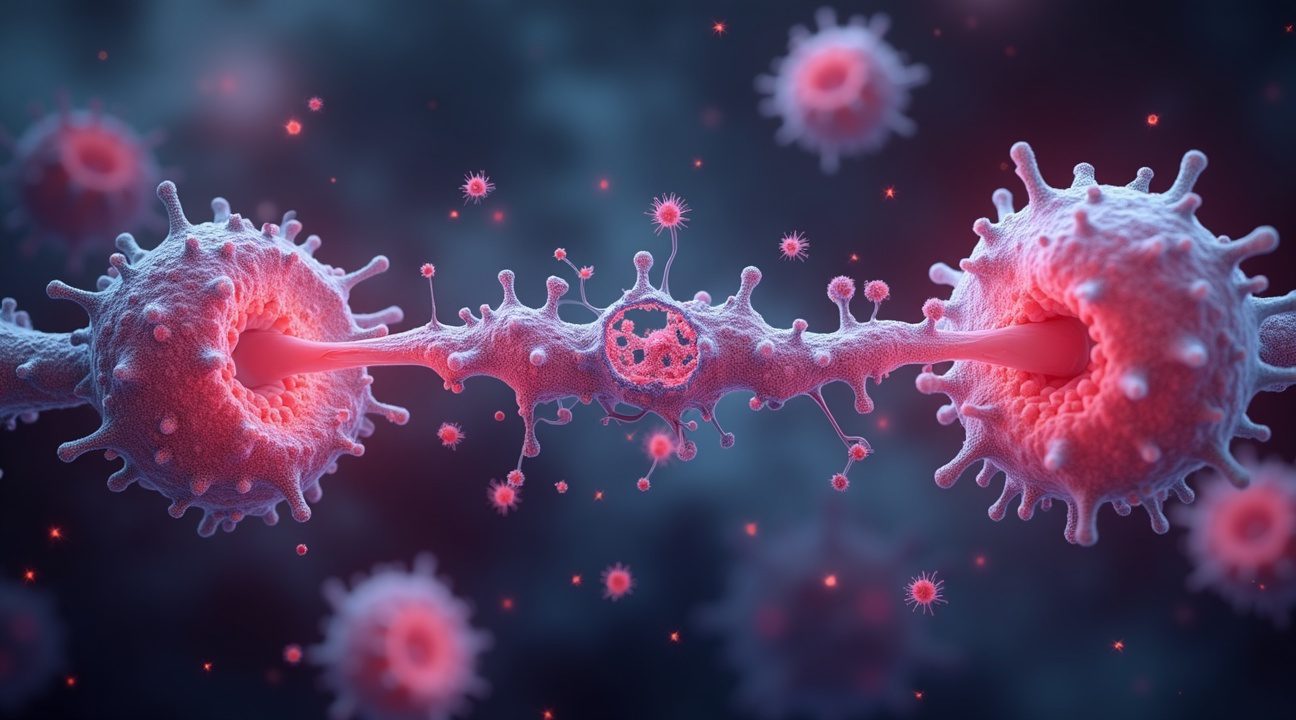Australian researchers at the Harry Perkins Institute of Medical Research have made a groundbreaking discovery that could revolutionize breast cancer treatment by identifying melittin, a compound in honeybee venom, as a potent cancer-fighting agent.
Their laboratory studies demonstrated that this natural peptide can eliminate aggressive breast cancer cells within 60 minutes while leaving healthy cells virtually unharmed, with 100% cancer cell death observed at specific concentrations.
Key Takeaways
- Melittin destroys aggressive breast cancer cells, including triple-negative and HER2-enriched types, within one hour while sparing healthy tissue.
- The compound operates through a dual mechanism: disrupting cancer cell membranes and interfering with critical growth signaling pathways.
- Synthetic melittin mimics natural bee venom effectively, addressing concerns about bee population sustainability and allowing for scalable production.
- Melittin enhances chemotherapy drugs, such as docetaxel, in animal studies when used in combination treatments.
- Nanoparticle delivery systems are in development to accurately target tumors and reduce side effects, with human clinical trials expected in the future.
For more detailed information, visit the Harry Perkins Institute of Medical Research.
Bee Venom Kills Aggressive Breast Cancer Cells in Just 60 Minutes
Groundbreaking Discovery from Australian Research
I’ve witnessed many scientific breakthroughs in my career, but the discovery by Australian researchers at the Harry Perkins Institute of Medical Research stands out as particularly remarkable. Their investigation into honeybee venom has revealed something extraordinary: this natural substance can eliminate aggressive breast cancer cells within a single hour while leaving healthy cells virtually untouched.
The research team focused on two of the most challenging forms of breast cancer to treat. Triple-negative breast cancer (TNBC) lacks the three most common types of receptors that doctors typically target with treatments, making it notoriously difficult to combat. HER2-enriched breast cancer, another aggressive variant, often shows resistance to conventional therapies. Yet both cancer types succumbed to the bee venom treatment in laboratory conditions.
What strikes me most about this research is the precision with which the venom works. At specific concentrations, the honeybee venom achieved 100% cancer cell death within 60 minutes. This level of effectiveness, combined with the minimal impact on normal cells, suggests a highly selective mechanism that could revolutionize cancer treatment approaches.
Melittin: The Active Component Behind the Discovery
The scientists identified melittin as the crucial element responsible for this cancer-killing effect. This small, positively charged peptide represents the primary active component in bee venom, and understanding its properties has opened new avenues for treatment development.
Melittin’s structure allows it to interact specifically with cancer cell membranes in ways that prove lethal to malignant cells. The researchers discovered that both naturally occurring melittin from bee venom and synthetically produced versions delivered identical results. This finding addresses a critical concern about sustainability and ethical treatment of bee populations.
Creating synthetic melittin means researchers can advance their studies without depleting bee colonies or causing harm to these essential pollinators. Given the ongoing environmental challenges facing bee populations worldwide, this approach ensures that potential medical advances don’t come at the expense of ecological balance.
The comprehensive nature of the study impressed me greatly. Over 312 honeybees and bumblebees contributed to this research, providing researchers with substantial data to validate their findings. This extensive sampling helped establish the consistency and reliability of melittin’s anti-cancer properties across different bee populations.
Laboratory experiments revealed that melittin disrupts specific cellular processes within cancer cells while sparing healthy tissue. The peptide appears to target membrane structures that differ between cancerous and normal cells, explaining the selective toxicity that makes this discovery so promising.
Early results suggest that melittin could work in combination with existing cancer treatments, potentially enhancing their effectiveness while reducing the severe side effects often associated with chemotherapy and radiation. The rapid action—complete cell death within one hour—offers hope for treatments that could work faster than current options.
The synthetic production capability removes barriers that might otherwise limit clinical applications. Pharmaceutical companies can now explore melittin-based treatments without concerns about sustainable sourcing or environmental impact. This development parallels other recent scientific advances where researchers have uncovered unexpected mechanisms in natural processes.
Clinical trials will determine whether these laboratory results translate into effective human treatments. The research team’s methodical approach and comprehensive testing provide a solid foundation for advancing this work from laboratory benches to hospital bedside applications.
How Melittin Destroys Cancer Cells While Sparing Healthy Tissue
Melittin demonstrates remarkable precision in attacking cancer cells through a two-pronged approach that leaves healthy tissue largely unharmed. The compound first targets cancer cell membranes directly, causing complete destruction within 60 minutes of exposure. This rapid membrane disruption proves particularly devastating for aggressive breast cancer cells that rely on intact cellular barriers for survival.
Dual Mechanism of Action
The compound operates through complementary pathways that amplify its cancer-fighting effectiveness. Within just 20 minutes, melittin disrupts critical signaling networks by interfering with EGFR and HER2 receptor activation. These receptors normally fuel cancer cell growth and division, but melittin’s interference effectively cuts off their communication channels. Cancer cells lose their ability to receive growth signals, while simultaneously facing structural damage to their protective membranes.
Statistical analyses reveal melittin’s impressive selectivity between cancerous and healthy cells. Cancer cells show vulnerability at concentrations of 5.58–5.77 ng/μL (IC₅₀ values), while normal human mammary and dermal cells remain largely unaffected until concentrations reach 22.17 ng/μL. This four-fold difference provides a substantial therapeutic window for treatment applications.
Different breast cancer subtypes respond variably to melittin treatment:
- Triple-negative breast cancer cells: Show exceptional sensitivity, making them prime candidates for melittin-based therapy.
- HER2-enriched breast cancer cells: Also demonstrate significant vulnerability to melittin.
- Hormone receptor-positive cancer types: Exhibit reduced sensitivity, suggesting melittin may work best as part of combination therapies for these variants.
The compound’s selectivity stems from fundamental differences between cancer and healthy cell membranes. Cancer cells often exhibit altered membrane compositions and increased permeability compared to normal cells. These structural differences make them more susceptible to melittin’s membrane-disrupting effects. Scientists have found that researchers find similar pattern recognition in other biological systems, though cancer cell targeting represents a unique application.
Complete cancer cell death occurs at specific melittin concentrations without causing comparable damage to surrounding healthy tissue. This precision targeting addresses a major challenge in cancer treatment – eliminating malignant cells while preserving normal cellular function. The discovery parallels other breakthrough findings where scientists find essential components work through previously unknown mechanisms.
Melittin’s effectiveness against particularly aggressive breast cancer forms offers hope for patients with limited treatment options. The compound’s ability to simultaneously attack cell structure and growth signaling creates multiple failure points for cancer cells, making resistance development more difficult.

Promising Results in Animal Studies and Combination Treatments
Scientists have achieved remarkable success with melittin in laboratory mouse models, where the bee venom compound demonstrated its ability to both slow tumor growth and amplify the effectiveness of established chemotherapy treatments. These animal studies represent a critical stepping stone between laboratory discoveries and potential human applications.
Enhanced Therapeutic Outcomes Through Drug Combinations
Mouse model experiments revealed that melittin doesn’t just work independently – it creates powerful synergistic effects when combined with docetaxel, a commonly used chemotherapy drug. The combination approach delivered superior tumor growth reduction compared to either treatment used alone. This finding suggests that melittin could potentially reduce the dosages of traditional chemotherapy drugs needed while maintaining or even improving treatment outcomes.
Researchers observed several key benefits during these animal trials:
- Significant reduction in tumor size and growth rate
- Enhanced penetration of chemotherapy drugs into cancer cells
- Improved survival rates compared to standard treatment protocols
- Reduced toxicity levels when lower chemotherapy doses were used alongside melittin
Early clinical observations, though limited in scope, have provided encouraging glimpses of melittin’s potential in human breast cancer patients. Some small-scale studies indicate that bee venom therapies may offer quality of life improvements, including pain reduction and decreased chemotherapy side effects. However, these preliminary findings require validation through extensive large-scale human clinical trials before any definitive conclusions can be drawn.
Current research efforts focus heavily on refining melittin’s cancer selectivity – essentially teaching the compound to distinguish more precisely between healthy cells and malignant ones. Scientists are exploring various modification techniques to enhance the compound’s natural ability to target cancer cells while leaving normal tissue unharmed. This precision targeting could dramatically reduce the side effects typically associated with cancer treatments.
The exploration of combination treatments represents another promising avenue of investigation. Researchers are systematically testing melittin alongside various standard chemotherapies to identify optimal drug pairings and dosing schedules. These studies examine how melittin might complement existing treatment protocols rather than replace them entirely.
Recent advances in delivery mechanisms have also captured researchers’ attention, as they work to develop more effective ways to transport melittin directly to tumor sites. Nanotechnology applications show particular promise, potentially allowing for targeted delivery that maximizes therapeutic impact while minimizing systemic exposure.
The timeline for human clinical trials remains uncertain, though researchers express cautious optimism about progressing from animal studies to human testing within the next few years. Regulatory approval processes require comprehensive safety data, which continues to accumulate through ongoing animal studies and refined laboratory experiments.
International collaboration has accelerated progress in this field, with research teams sharing findings and coordinating efforts to advance melittin-based treatments more rapidly. Multiple institutions are contributing specialized expertise in areas ranging from venom chemistry to cancer biology, creating a comprehensive approach to development.
Manufacturing considerations also play a crucial role in future applications. Scientists must develop scalable production methods that can generate sufficient quantities of purified melittin for clinical use while maintaining consistent quality and potency. Current research explores both synthetic production methods and optimized extraction techniques from natural bee venom sources.
The potential for personalized medicine applications adds another layer of complexity and opportunity to melittin research. Ongoing investigations examine whether genetic markers or tumor characteristics could predict which patients might respond most favorably to melittin-based treatments, potentially enabling more targeted therapeutic approaches in the future.

Advancing Toward Human Clinical Trials Through Improved Delivery Methods
Scientists are actively working to bridge the gap between promising laboratory results and practical cancer treatment through sophisticated delivery systems. Dr. Edina Wang and her research team are developing nanoparticle delivery mechanisms that can precisely target tumor sites while protecting healthy tissue from exposure to melittin.
These engineered nanoparticles act like microscopic guided missiles, recognizing specific markers found on cancer cell surfaces. Once they reach their destination, the particles release their melittin payload directly into the tumor environment. This targeted approach addresses one of the primary challenges researchers face when trying to harness bee venom compounds for medical use – ensuring the treatment affects only diseased cells.
Current investigations extend beyond melittin alone, as scientists examine other minor components within honeybee venom that might possess anti-cancer properties. Early research suggests that combinations of these compounds could potentially enhance therapeutic effectiveness while reducing required dosages.
Critical Steps Before Patient Treatment
The path from laboratory discovery to bedside application requires several essential phases of validation:
- Comprehensive toxicity studies to determine safe dosage ranges for humans
- Pharmacokinetic analysis to understand how the body processes and eliminates the compounds
- Large-scale manufacturing protocols for consistent nanoparticle production
- Regulatory approval processes through health authorities
- Multi-phase clinical trials involving hundreds or thousands of participants
Most current evidence comes from controlled laboratory environments and animal studies, which don’t always predict human responses accurately. Research teams acknowledge that translating these promising findings into effective patient care remains uncertain without extensive clinical testing.
The transition from animal models to human trials presents unique challenges. Cancer cells behave differently in living organisms compared to laboratory dishes, and human immune systems may react unpredictably to bee venom derivatives. Scientists must carefully evaluate potential side effects, drug interactions, and long-term safety profiles before proceeding with patient studies.
Researchers are also investigating optimal treatment schedules and combination therapies. Questions remain about whether melittin-based treatments work best alone or alongside existing chemotherapy drugs and radiation therapy. These considerations require extensive preclinical testing to establish the most effective treatment protocols.
The development timeline for bringing bee venom compounds to clinical use typically spans several years. Initial Phase I trials focus on safety and dosage determination, followed by Phase II studies that assess effectiveness in specific cancer types. Phase III trials compare new treatments against current standard therapies, involving larger patient populations across multiple medical centers.
Funding for these comprehensive studies remains a significant consideration. Pharmaceutical companies and research institutions must invest substantial resources in clinical trial infrastructure, patient recruitment, and regulatory compliance before any potential return on investment.
Manufacturing consistency presents another hurdle. Producing pharmaceutical-grade nanoparticles requires precise quality control measures to ensure each batch contains identical melittin concentrations and particle characteristics. Variations in production could lead to unpredictable treatment outcomes or safety issues in clinical settings.
Regulatory agencies will scrutinize all aspects of melittin-based treatments, from raw material sourcing to final product stability. Documentation requirements include detailed manufacturing processes, quality assurance protocols, and comprehensive safety data from all preclinical studies.
Despite these challenges, research teams remain optimistic about melittin’s therapeutic potential. The compound’s ability to selectively destroy aggressive breast cancer cells while sparing healthy tissue represents a significant advancement in targeted cancer therapy development. Success in human trials could open doors for treating other cancer types and potentially revolutionize how doctors approach tumor elimination.
Safety Concerns and Current Research Limitations
While melittin shows remarkable promise against aggressive breast cancer cells, several critical safety hurdles must be addressed before this discovery can benefit patients. The most pressing concern centers on toxicity levels, as higher or uncontrolled doses of this bee venom compound can damage healthy cells alongside cancerous ones.
Toxicity and Allergic Reactions
The compound’s potency works as both its greatest strength and most significant weakness. Melittin’s ability to destroy cancer cells within an hour becomes dangerous when dosage levels aren’t precisely controlled. Researchers have observed that concentrations exceeding therapeutic ranges can harm normal tissue, creating a narrow window for effective treatment.
Allergy risks present another substantial barrier. Bee venom reactions affect millions of people worldwide, ranging from mild irritation to life-threatening anaphylaxis. Patients would require comprehensive screening for bee venom sensitivities before receiving any melittin-based therapy. Even individuals without previous reactions could develop sensitivities during treatment, necessitating constant monitoring and emergency preparedness protocols.
Research Limitations and Clinical Translation
Current evidence remains confined to laboratory studies and animal models, creating uncertainty about human applications. Scientific breakthroughs often face significant challenges when transitioning from controlled laboratory environments to clinical practice. The cellular responses observed in petri dishes don’t always replicate in living patients with complex immune systems and varying health conditions.
Dosage control represents perhaps the most critical challenge facing researchers. Determining optimal therapeutic levels requires extensive testing to establish:
- Minimum effective concentrations for different cancer types
- Maximum safe doses for various patient populations
- Delivery methods that ensure precise targeting
- Timing protocols for treatment administration
The research team must also account for individual patient variations, including body weight, metabolism rates, and concurrent medications that might interact with melittin. Without standardized dosing protocols, the treatment remains too risky for human trials.
Additional complications arise from melittin’s non-specific nature. While it effectively targets aggressive breast cancer cells, the compound doesn’t distinguish between cancer types or stages. Researchers need to develop methods for directing melittin specifically to tumor sites while protecting healthy tissue throughout the body.
Scientific discoveries require years of careful validation before reaching patients. The bee venom compound shows exceptional promise, but extensive clinical trials must demonstrate both safety and efficacy in human subjects before any therapeutic applications become available.

Current Research Focus on Enhanced Targeting and Venom Components
Scientists continue advancing melittin research through targeted improvements that could transform cancer treatment options. Dr. Edina Wang and her research team are developing sophisticated methods to enhance the compound’s ability to distinguish between cancerous and healthy cells. Their work focuses on refining melittin’s natural selectivity properties, ensuring treatments attack only malignant tissue while preserving normal cellular function.
Precision Targeting Through Nanoparticle Innovation
Advanced delivery systems represent the next frontier in melittin-based cancer therapy. Researchers are engineering specialized nanoparticles that act as microscopic vehicles, carrying the bee venom compound directly to tumor sites. These delivery mechanisms promise unprecedented precision in cancer treatment, potentially eliminating the side effects associated with conventional chemotherapy.
The nanoparticle approach allows scientists to control exactly where and when melittin releases its cancer-fighting properties. Just as researchers find new species in unexplored depths, cancer scientists are discovering innovative pathways to deliver therapeutic compounds with surgical precision. This targeted delivery system could revolutionize treatment protocols by maximizing therapeutic impact while minimizing collateral damage to healthy organs.
Exploring Additional Venom Components
Beyond melittin, honeybee venom contains numerous minor compounds that researchers believe may contribute to anti-cancer effects. Scientists are systematically analyzing these secondary components to understand their individual therapeutic potential. Early investigations suggest that certain peptides and enzymes within bee venom could work synergistically with melittin, creating more powerful treatment combinations.
Research teams are examining how these additional compounds might enhance melittin’s effectiveness or provide alternative treatment pathways. Some components show promise in addressing different cancer cell mechanisms, potentially offering multiple therapeutic targets within a single venom-derived treatment. This comprehensive approach mirrors how scientists think about complex neurological phenomena – investigating multiple contributing factors rather than focusing on single causative elements.
Future research priorities include determining optimal melittin concentrations for human application. Scientists must establish precise dosing protocols that maximize cancer cell destruction while maintaining safety margins for healthy tissue. This delicate balance requires extensive testing and careful calibration of treatment parameters.
Clinical trials will focus on translating laboratory successes into practical medical applications. Researchers are developing standardized protocols for venom compound extraction, purification, and preparation. These processes must meet pharmaceutical manufacturing standards while preserving the active properties that make melittin so effective against cancer cells.
The timeline for human trials depends on successful completion of enhanced targeting studies and nanoparticle delivery system development. Scientists anticipate that improved selectivity mechanisms will address current limitations and pave the way for clinical applications. Research continues examining how environmental factors and individual patient characteristics might influence treatment effectiveness.
Collaboration between cancer research institutions accelerates progress in venom-based therapy development. Teams share findings about compound optimization, delivery methods, and targeting improvements. This cooperative approach ensures that breakthrough discoveries quickly benefit the broader scientific community and ultimately cancer patients worldwide.
As NASA scientists find essential building blocks in unexpected places, cancer researchers are uncovering therapeutic potential in natural compounds previously overlooked. The systematic investigation of bee venom components represents a paradigm shift in cancer treatment research, moving from synthetic drug development to bio-inspired therapeutic approaches.
Current studies also examine how melittin interacts with existing cancer treatments. Researchers investigate potential combination therapies that could enhance overall treatment effectiveness. These investigations could lead to integrated treatment protocols that combine venom compounds with conventional therapies for improved patient outcomes.

Sources:
ecancer.org
PMC
perkins.org.au
Breaking Cancer News
UCLA Health
Nature
Facing Our Risk


